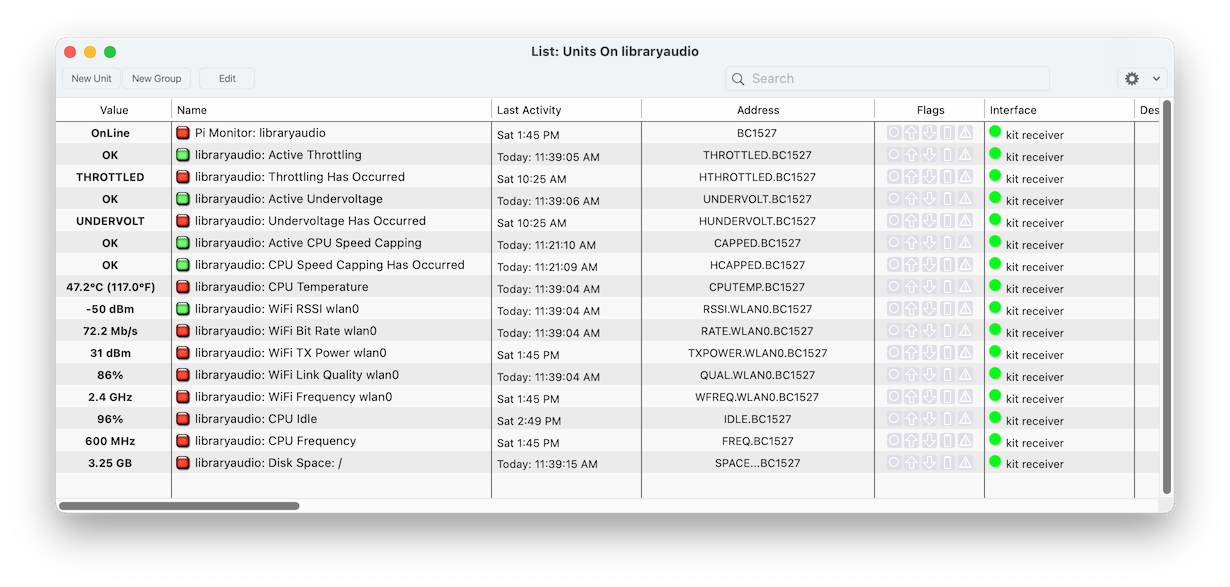Table of Contents
Raspberry Pi Monitor
Not really a plugin for XTension but a program you can run on a Raspberry Pi in order to monitor it’s health. The program is written in Python, is open source and available to install via the instructions on the GitHub PiMonitor Repository
It is often difficult or impossible to check the quality of the power supply or temperature of a Pi remotely. You can ssh in and run the command line tools to check, but in order to know what is happening in realtime a better tool is required. This program will create Units in XTension representing the state of the Pi which update in more or less realtime.
The plugin requires that the Pi be on the same subnet as the XTension machine and that you are running a single instance of the XTension Kit Plugin which will receive the data from any number of Pi’s or other devices that implement that protocol.
As of this moment 1/19/2022, the XTension version that supports this is not yet released and the program itself is still undergoing testing and revisions. You may wish to wait to experiment with this until the software is released which will be soon.
Monitored Information:
Any of the monitoring checks and be turned on or off in the configuration file installed on the Pi. By default you get all of these except the CPU Frequency check which can change so rapidly that it will cause a lot of traffic and load. If that would be helpful then you can enable it on the individual Pi.
- Status Unit: The first unit created shows the online/offline status of the pi. If the program is quit normally via a reboot or other shutdown this will turn off and show a label of offline. If the pi hangs or drops off the network for more than 4 minutes the unit will timeout and switch to offline as well.
- Active Undervoltage: Will be on if the pi is currently in an undervoltage state. This can switch on and off rapidly as the problem comes and goes with varied load.
- Undervoltage Has Occurred: Will be on if the pi has had any undervoltage events since the last reboot.
- Active Throttling: Will be on if the pi is currently in a speed throttled state.
- Throttling Has Occurred: Will be on if the pi has had any throttling events since the last reboot.
- Active CPU Speed Capping: Will be on if the pi has had it's speed capped at any time since the last reboot.
- CPU Speed Capping Has Occcurred: Will be on if the pi has had any speed capping events since it's last reboot.
The first 7 units above will always be created, the following ones will either be present or not depending on your configuration.
- CPU Temperature: The CPU temperature as reported by the pi, in whatever format and label settings that you set in the configuration file below.
- WiFi RSSI: The RSSI in dbm as read from the configured WiFi interface. Numbers closer to 0 are better.
- WiFi Bit Rate: The bit rate that the wifi is currently running as. Very low nubers may indicate a reception or link quality issue.
- WiFi TX Power: How much power the wifi has to broadcast to reliably reach the access point.
- WiFi Link Quality: A simple percent value taking into account the other values.
- WiFi Frequency: The channel that the WiFi radio is operating on
- CPU Frequency: Turned off by default in the configuration, the speed the CPU is currently running at. This will change rapidly according to the load the device is under.
- CPU Idle: The percent idle of the CPU if turned on in the configuration file.
- Disk Space: A Disk Space unit will be created for each mount point that you setup to be scanned for disk space usage. The default name of the unit will be the hostname of the pi, “Disk Space” and the path to the mountpoint.
Note that the standard default naming convention for new units is the hostanme of the pi and then the descriptive name along with any other information needed. Once the units are created new information is targeted to them via their Address and not their name. You can edit the name at any time to be more descriptive or useful to you.
History:
- Version 1.0 of this program is compatible with XTension versions 9.4.45 and newer released in January of 2022

